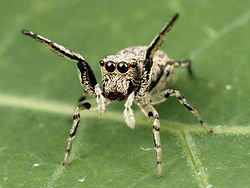| Zygoballus | |
|---|---|
 | |
| Adult male Zygoballus rufipes (hammerjawed jumper) from Massachusetts | |
| Scientific classification | |
| Kingdom: | Animalia |
| Phylum: | Arthropoda |
| Subphylum: | Chelicerata |
| Class: | Arachnida |
| Order: | Araneae |
| Infraorder: | Araneomorphae |
| Family: | Salticidae |
| Subfamily: | Salticinae |
| Genus: | Zygoballus Peckham & Peckham, 1885 [1] |
| Type species | |
| Zygoballus rufipes Peckham & Peckham, 1885 | |
| Species | |
| Diversity | |
| approx. 20 species | |
| Synonyms | |
| |
Zygoballus is a genus of jumping spiders found in North and South America.
